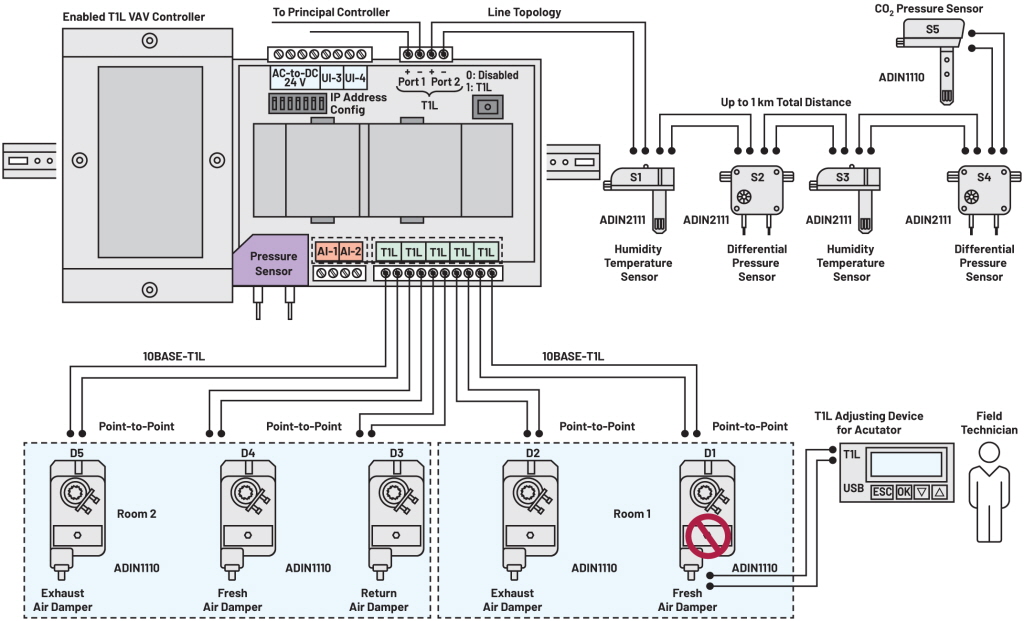10BASE-T1L 빌딩 컨트롤러를 활용하여 지속 가능한 빌딩 관리 시스템을 구축하는 방법에 대해 아나로그디바이스(Analog Devices, Inc., ADI)의 살렘 가비(Salem Gharbi) 시스템 애플리케이션 엔지니어에게 들어봤다.
고전력 게이트웨이 불필요·단일 케이블로 장거리 센서·엑추에이터 제어
네트워크 장애 모니터링·장애 감지·케이블 진단 기능 사용해 문제 해결
■ 개요
이 글에서는 빌딩 관리 시스템(building management systems, BMS)에서 빌딩 컨트롤러라고도 부르는 이더넷 기반 직접 디지털 컨트롤러(Ethernet direct digital controller, Ethernet DDC) 활용의 이점을 살펴보고, 10BASE-T1L 프로토콜이 통상적인 BMS 구조에 얼마나 적합할 수 있는지를 설명한다.
10BASE-T1L 기술은 10Mbps의 데이터 전송속도, 다양한 토폴로지 지원, 단일 쌍 연선 케이블(single-twisted pair cable)을 통한 전원 공급 등의 특성을 갖추고 있어 점-대-점(point-to-point), 링(ring), 라인(line) 네트워크 구성에서 DDC 컨트롤러와 엣지 노드에 대해 매끄러운 이더넷 연결을 제공한다.
이는 거의 무제한에 가까운 수의 엣지 노드를 지원하면서, 실시간 제어를 제공하고, 이전 프로토콜의 한계를 극복한다.
최대 1km까지 장거리 데이터 전송이 가능해 기존의 단일 쌍 연선 케이블을 재사용할 수 있기 때문에 기존 BMS를 개조하는 데 적합한 솔루션이 된다.
이러한 기능들은 전력 소모가 많은 게이트웨이의 필요성을 제거하여 엣지-클라우드 연결을 원활하게 해준다.
이는 최신 BMS 기술에 관심을 가지고 있거나, 건물내 에너지 효율성에 미치는 잠재적 영향에 대한 관심을 갖고 이들에게는 상당히 중요한 자원이 된다.
■ T1L 기반 DDC
DDC(direct digital controller) 시스템은 현대식 빌딩 관리에 필수이며, 다양한 빌딩 시스템을 실시간으로 모니터링하고 제어할 수 있게 해준다.
기술이 발전함에 따라, 이더넷 연결이 가능한 DDC 시스템이 더욱 널리 보급되어 빌딩의 효율성과 안전성은 한층 더 향상될 것이다.
아나로그디바이스(Analog Devices Inc., ADI)의 ADIN1100 PHY, ADIN1110 MAC PHY, ADIN2111 2포트 스위치는 DDC 시스템에 10BASE-T1L 기술을 추가하는 데 매우 이상적인 솔루션이다.
이 기술은 프로세스 값, 설정 정보, 소프트웨어 업데이트 및 진단 내용을 전송할 수 있게 하여 빌딩 시스템 관리 및 유지보수를 보다 쉽게 한다.
최대 길이 1km의 긴 케이블 사용이 가능한 10BASE-T1L 기술은 시스템 내 모든 결함을 빠르고 효율적으로 해결할 수 있는 진단 기능을 갖추고 있다.
10BASE-T1L과 Modbus IP 및 BACnet IP와 같은 소프트웨어 스택의 통합은 산업 자동화 시스템을 위한 포괄적인 솔루션을 제공하여 효율적인 데이터 수집, 장치 제어 및 시스템 모니터링을 용이하게 한다.
그림 1은 링 또는 라인 토폴로지로 다수의 방 또는 빌딩 컨트롤러와의 통신을 위해 10BASE-T1L 제품을 HVAC(난방, 환기 및 공조) 컨트롤러 및 방 컨트롤러에 통합하는 방법을 보여준다.
■애플리케이션: HVAC 시스템에서의 T1L 기반 VAV 컨트롤러
○ VAV의 정의
가변 풍량(variable air volume, VAV) 시스템은 현대식 사무용 빌딩에서 사용되는 일반적인 HVAC 장치/컨트롤러로, 여러 대의 시스템들이 서로 다른 구역/면적에 설치되어 실내 온도를 쾌적한 수준으로 유지한다.
이 시스템은 온도를 일정하게 유지하면서 공급되는 공기의 양을 조절함으로써, 동일한 환기 시스템을 사용하여 각각의 구역들이 서로 다른 온도에서 작동할 수 있도록 한다.
적절한 환기를 보장하기 위해, VAV 시스템들은 DDC 프로그래밍을 사용하여 필요한 댐퍼 조정을 계산하고 명령한다.
프로그래밍이 가능한 최신 VAV 구역 컨트롤러는 빌트인 액추에이터를 포함하고 있으며, 터미널 팬을 작동시키고 해당 공간으로 유입되는 조화 공기의 흐름을 조절함으로써 실내 온도를 유지한다.
이 컨트롤러는 단일 덕트, 병렬 팬 박스 터미널, 그리고 가변 난방기능을 지원하는 직렬 팬 박스 터미널을 위한 전용 제어 기능을 제공한다.
이 컨트롤러는 댐퍼 액추에이터와 통합 프로그래밍이 가능한 DDC라는 두 가지 주요 블록으로 구성된다.
또한 VAV 애플리케이션에서 풍량을 적절하게 조정하고 공기의 질을 모니터링 하는데 필요한 다양한 센서의 인터페이스를 지원한다.
프로그래밍이 가능한 VAV 구역 컨트롤러는 구역 온도 측정과 표시, 점유 상태 감지, 덕트 온도 측정, 배출 공기 온도 측정, 구역 습도 및 이슬점 측정, 이산화탄소(CO₂) 레벨 감지 그리고 AV 박스 팬 속도 제어를 할 수 있다.
공항과 같은 대형 건물에서 10BASE-T1L 컨트롤러를 사용하면 최적의 에너지 효율과 실내 공기 질을 제공하는 동시에 유지관리 및 운영 비용을 절감할 수 있다.
.jpg)
▲그림1. T1L 지원 빌딩 컨트롤러 예시
이 활용 사례에서는 공항의 특정 구역에 초점을 맞출 것이다(그림 2).
그러나, 여기서 설명하는 VAV 시스템과 제어 알고리즘은 다른 대형 빌딩에도 적용할 수 있다는 점을 주목할 필요가 있다.
이 구역에는 두 개의 방이 있으며, 해당 VAV 시스템은 동일 구역 내 덕트설비를 가로질러 서로 다른 위치에 배치된 5개의 센서와 액추에이터를 사용하고 있다.
첫 번째 방에는 액추에이터(D1 및 D2) 2개, 온도 센서(S1) 1개, 압력 센서(S2) 1개가 사용되었다.
S1과 S2는 터미널 근처의 공기 공급 덕트 내에 있으며, D2는 배기 댐퍼로 사용하고, D1은 흡기 댐퍼로 사용하여 실내 공기 흐름을 제어한다.
마찬가지로 두 번째 방에서도 동일한 수의 센서와 액추에이터(D3, D4, S3, S4)를 사용하지만, 실내에 추가된 부하로 인해 환기 덕트 안에 이산화탄소 센서(S5) 1개와 별도의 액추에이터(D5) 1개를 추가함으로써 공기 흐름과 공기질을 더 잘 제어할 수 있도록 한다.
이 VAV 제어 장치는 제어 루프 알고리즘을 사용하여 센서와 액추에이터를 모니터링하고 제어한다.
온도 및 압력 센서의 판독값을 기반으로 댐퍼 위치를 조정한 다음 프로그래밍 방식에 따라 작동시킨다.
예를 들어 1번 방에서 온도가 변하면 VAV 장치가 댐퍼 D1과 D2를 여닫기 시작하여 공기 공급 덕트 내의 압력 변화를 유발하고 압력센서(S2)로 그 변화를 감지한다.
압력이 증가하면 VAV 장치가 그 변화를 인식하고 공기 처리 장치(air handling unit, AHU)에 위치한 팬이 느려지도록 조절한다.
모든 센서는 라인 토폴로지에 연결되며, 덕트설비의 서로 다른 위치에 배치된다.
각 댐퍼는 점대점(point-to-point) 토폴로지를 사용하여 VAV 장치에 직접 연결된다.
기존 인프라 구조에서는 케이블 길이, 임피던스, 두께 그리고 가장 중요한 DC 루프 저항 등에 대한 제한으로 인해 심각한 제약을 받았다.
그러나 이러한 문제를 해결하기 위해, 1km 이상의 거리에서도 단일 연선 케이블을 통해 센서 및 액추에이터 네트워크를 실시간으로 제어할 수 있도록 10BASE-T1L DDC 컨트롤러가 사용된다.
또한 10BASE-T1L 조정 디바이스 액추에이터는 원격으로 댐퍼 작동 시간을 최소화하고, 위치를 최적의 세팅으로 조절할 수 있게 하며, 고장 시에는 댐퍼를 평가하는 데에도 사용할 수 있다.
VAV 시스템은 공항과 같은 대형 건물에서 쾌적한 환경을 유지하기 위한 강력한 도구이다.
서로 다른 여러 위치에 배치되어 있는 센서와 액추에이터를 이용함으로써, VAV 장치는 공기 흐름과 공기질을 조절하여 일정한 온도와 압력을 유지할 수 있다.
10BASE-T1L DDC 제어장치와 같은 첨단 기술의 도움으로, HVAC 시스템은 더 효율적으로 제어되고 유지 관리되며, 향상된 효율로 에너지 절약에 기여한다.

▲그림2. T1L 지원 VAV 컨트롤러 예시
빌딩 컨트롤러에 10BASE-T1L을 추가하면, 복잡한 고전력 소모 게이트웨이를 사용할 필요가 없고, 단일 연선 케이블을 통해 장거리에서 센서와 액추에이터를 실시간으로 제어할 수 있어 BMS 성능이 향상된다.
빌딩 컨트롤러는 네트워크 성능과 요구 사항에 따라 거의 무제한에 가까운 엣지 디바이스를 사용하여 더 넓은 도달 범위를 달성할 수 있다.
10BASE-T1L을 지원하는 빌딩 컨트롤러는 네트워크 장애를 모니터링하고, 장애 감지 및 케이블 진단 기능을 사용하여 케이블 문제를 확인할 수도 있다.
※ 저자 소개
살렘 가비(Salem Gharbi)는 아나로그디바이스(Analog Devices) 지속 가능한 빌딩 및 인프라 사업부의 시스템 애플리케이션 엔지니어이다. 그는 다양한 IoT 및 산업 애플리케이션에서 7년 동안 재직해 오면서 산업 자동화 중심의 시스템 수준 솔루션을 제공하는 역할을 맡고 있다.
.jpg)
 ▲그림2. T1L 지원 VAV 컨트롤러 예시
▲그림2. T1L 지원 VAV 컨트롤러 예시